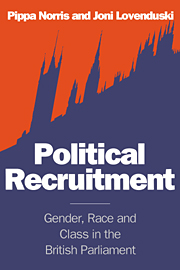Book contents
- Frontmatter
- Contents
- List of figures
- List of tables
- Preface
- 1 Puzzles in political recruitment
- Who selects and how?
- 2 The structure of political recruitment
- 3 Conservative recruitment
- 4 Labour recruitment
- 5 Minor party recruitment
- Who gets selected, and why?
- Does the social bias matter?
- Appendix A Details of the survey design and sample
- Appendix B Questionnaires
- Notes
- Bibliography
- Index
5 - Minor party recruitment
Published online by Cambridge University Press: 07 December 2009
- Frontmatter
- Contents
- List of figures
- List of tables
- Preface
- 1 Puzzles in political recruitment
- Who selects and how?
- 2 The structure of political recruitment
- 3 Conservative recruitment
- 4 Labour recruitment
- 5 Minor party recruitment
- Who gets selected, and why?
- Does the social bias matter?
- Appendix A Details of the survey design and sample
- Appendix B Questionnaires
- Notes
- Bibliography
- Index
Summary
In British elections in the post-war period, as noted earlier, one of the most striking developments has been the growth of candidate competition. In the 1951 election there were 2.2 candidates per seat; over three quarters of all contests were ‘straight rights’ between the Labour and Conservative candidates; there were even a handful of uncontested Conservative seats. The 1951 campaign was fought by only 142 minor party candidates (109 Liberals, 10 Communists, 6 nationalists, and 17 others). In contrast, since October 1974 there have been at least three contestants for almost every seat, as the Liberals put up candidates in virtually every constituency. Other parties have become more competitive until by the 1992 election there were 4.5 candidates per seat, a record number. The most serious challenge has come from the Liberal party, later the Liberal/Social Democrat Alliance, and now the Liberal Democrats. The strength of the Nationalist parties and the Greens, plus fringe and independent candidates, has also contributed towards this trend. We need to understand how recruitment operates in these parties, and whether the process and outcome differs significantly from the major parties.
There are good reasons why we might expect to find a distinctive pattern of recruitment in the minor parties, in terms of the motivation, experience and background of candidates. Many ambitious politicians seek a full-time political career on the Labour and Conservative back-benches, but it is more difficult to understand the motivation of candidates in other parties, given their chances of winning.
- Type
- Chapter
- Information
- Political RecruitmentGender, Race and Class in the British Parliament, pp. 77 - 90Publisher: Cambridge University PressPrint publication year: 1994

